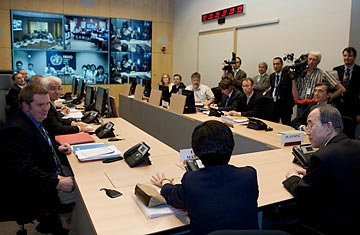
The World Health Organisation's Strategic Health Operations Centre in switzerland
That very question was addressed in 2005, when the WHO revamped its pandemic response system, instituting six ascending phases, each with specific criteria used to judge an emerging influenza virus. The WHO created the new pandemic alert scale after the SARS outbreak of 2003, when the health organization was forced to improvise its response to that emerging new disease.
Right now the pandemic alert remains at phase 5, signifying that a new flu virus has spread easily from person to person in one region of the world. If the WHO judges that the H1N1 virus has begun circulating widely in another region, it should trigger phase 6, which would mean a pandemic is officially under way. It's worth noting that, at least on paper, the pandemic phases do not take into account the virulence of a new disease — only its transmissibility. (Read TIME's cover story "How to Prepare for a Pandemic.")
The declaration of a pandemic would likely lead to tabloid headlines, travel restrictions and a hit to the global economy. That's why a number of countries at the WHO's annual World Health Assembly, which began on May 18, pressed the global body to include the severity of a new virus when rating a pandemic. Despite its initial resistance, now it looks like the WHO will bend to political pressure, according to Keiji Fukuda, the WHO's interim director-general for health, safety and environment; the body will change its alert system in the future to take severity into account. That will add a new complication to response. Determining the virulence of a new disease takes time, and flu viruses can mutate unexpectedly to become more (or less) severe.
We'll never know for sure whether the immediate response to the early cases of H1N1 — the border surveillance and school closings, for example — successfully dampened the virus's spread, but it seems a mistake to wait to see how deadly a disease is before sounding the global alarm.